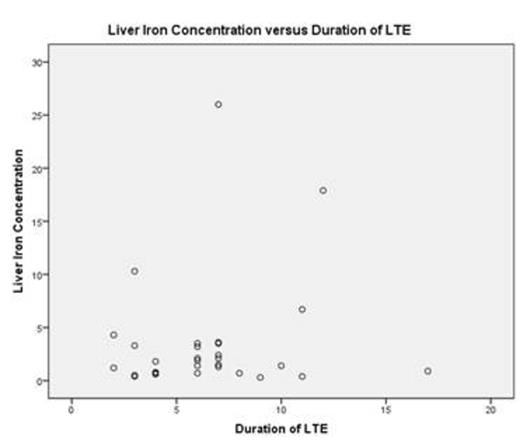Abstract
Background:
Observational studies and randomized clinical trials have demonstrated that RBC transfusions can alleviate or prevent many complications of sickle cell disease (SCD). Obligatory iron loading is most problematic for those receiving chronic simple transfusions and is managed with chelation therapy to prevent hepatic, cardiac, and endocrinologic complications. Erythrocytapheresis procedures are increasingly used in SCD as they achieve dilution of hemoglobin S without significantly raising the total hematocrit. Some guidelines for the management of iron overload use serum ferritin levels, but non-invasive measurements of liver iron concentration (LIC) using validated and widely available MRI techniques have been described. There is a paucity of data elucidating the impact of long-term erythrocytapheresis (LTE) on LIC. We evaluated LIC with MRI and serial serum ferritin measurements among a population of SCD patients maintained on LTE at a single institution.
Methods:
Subjects with SCD maintained on the LTE program included those with elevated TCD, history of stroke, recurrent acute chest syndrome, or frequent pain crises unresponsive to hydroxyurea therapy. Serial serum ferritin measurements were followed and chelation with deferasirox was initiated for consistent ferritin level >1000 ng/mL. MRI of liver and cardiac iron was measured on all LTE subjects with non-contrast MRI techniques. A total of n=31 subjects maintained on LTE were enrolled and stratified into two groups: high LIC, ≥5mg/g of dry tissue (n=4, 12.9%) and low LIC, <5mg/g (n=27, 87.1%). Chi-squared and t-test were used to test for differences between the two groups. Logistic regression was used to test what impacted the odds of having a high LIC, while generalized linear mixed-effects modeling was used to test what impacted LIC.
Results:
None of the subjects had high cardiac iron concentration. Subjects with high LIC were significantly older (17.8 vs. 13.1, p=0.032) and were more likely to be female (100% vs. 44.4%, p=0.038). The duration of LTE was not associated with high and low levels of LIC (8.25 vs. 6.15, p=0.240, Figure 1), levels of LIC (r=0.247, p=0.188, Figure 2), or serum ferritin (r=0.077, p=0.680). The total number of simple of transfusions was not associated with serum ferritin (r=-0.177, p=0.558) or LIC (r=-0.022, p=0.910). Serum ferritin was not significantly associated with LIC (r=0.296, p=0.112, Figure 3). One of the 4 patients with high LIC required chelation with deferasirox for ferritin >1000 ng/mL. Three of the 31 subjects required iron chelation with deferasirox.
Conclusions:
There was no significant correlation between duration of LTE and LIC. The impact of cumulative simple transfusions on LIC was obviated by maintenance LTE. These findings are consistent with reports that LTE is associated with reduced transfusional iron overload. The lack of significant association between serum ferritin and LIC suggest that validated MRI measurements of LIC may have greater sensitivity for identifying patients with iron overload and guidelines for iron chelation should consider LIC rather than serum ferritin alone.
Duration of LTE (years) was not associated with high and low levels of LIC.
No relevant conflicts of interest to declare.
Author notes
Asterisk with author names denotes non-ASH members.




This feature is available to Subscribers Only
Sign In or Create an Account Close Modal